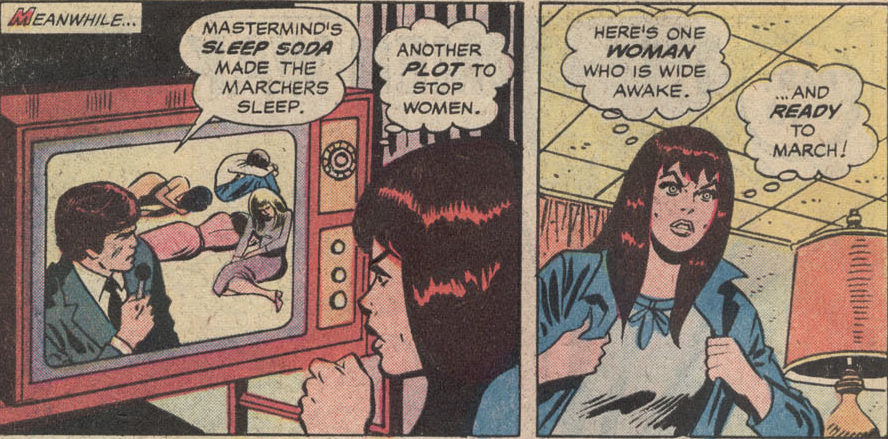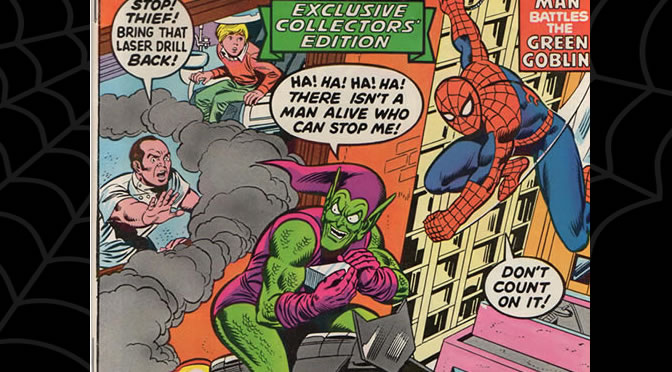According to Marvel.com today marks 45 years since ASM #122, the second half of the Death of Gwen Stacy storyline. In honour of that today we’re going to look at part of that issue. Specifically just one page…
I am of course referring to the iconic last page of the story. In possibly the nine greatest collective panels in comic book history we see Mary Jane awaiting Peter in his apartment after learning of the death of her friend (and Peter’s girlfriend) Gwen Stacy. She offers some condolences when Peter returns obviously distraught. In response he blows up at her and angrily berates her for not caring about anybody except herself. As he wallows in despair a visibly hurt MJ opens the door to leave, pauses and then defiantly closes it.

Powerful stuff for sure and it’s been discussed to death across the four and a half decades since its release.
In truth I have very little to add to the conversation that most people reading this haven’t heard before or else will inevitably hear since analysis of this story is so common.
But what I do have to add is that while many people regard this story as the end of the Silver Age, they often forget that it was in fact the opening salvo to Gerry Conway’s mega arc that played out across the rest of his run.
The Death of Gwen Stacy storyline might have ended Gwen and (temporarily) Norman Osborn’s character arc, but it began exciting new chapters for Harry Osborn and Mary Jane, the ramifications of which can still be seen today.
Things culminated in Gerry Conway’s original Clone Saga storyline when Peter was confronted with a seemingly resurrected Gwen Stacy just as he and Mary Jane were taking their relationship in a new and serious direction. The revived Gwen would turn out to be a clone of the genuine article, created by Peter’s college professor Miles Warren due to his own heartbreak over Gwen’s death.
The whole arc is a grand metaphor about grieving a loved one, moving on and how important it is to have people in your life to support you in order for you to do that. Peter and Miles Warren were both grieving Gwen but Peter had MJ and through his relationship with her he was able to move on and let Gwen go. This was put to the ultimate test when Gwen turned back up, a literalised metaphor for the guilty feelings many people have when they begin to truly move on after the loss of a loved one.
Miles Warren was not so fortunate. He was alone in his grief and it created an unnatural obsession to develop, compelling him to defy nature itself by ‘resurrecting’ Gwen via cloning. His pursuit of bringing back his dead love and punishing those he held responsible for taking her away ultimately turned him into a monster. In a sense the Jackal is what Peter might have become if he had not let Gwen go and had not had Mary Jane in his life to help him do that.
The last page of the story (and Conway’s entire 1970s ASM run) is another single page epilogue. Peter returns to his apartment (a new one since Gwen died, he’d had to move out around a dozen issues earlier) somewhat upset about the Gwen clone’s departure and Miles Warren’s apparent death. He suddenly realizes Mary Jane is waiting for him inside and upon opening the door exclaims he is glad to see her. He enters the apartment to be with MJ and closes the door behind him.

Once again this is another great scene all on its own.
But together both epilogue pages reveal the sheer brilliance of Conway’s writing which was arguably ahead of its time in the mid-1970s.
The last page of ASM #122 showcases Mary Jane starting to change as a person from the carefree party girl we’d known her as and plants the seed for her and Peter’s relationship in consequent issues.
However on a meta level it is symbolically conveying that Mary Jane is here to replace Gwen in the role of love interest within the narrative of the series. And it affirms that she will not be thrown out by Gwen or her memory. The scene is her telling Peter as well as the readers that she’s here to stay!
This is then bookended on the last page of ASM #149. Like in ASM #122 Mary Jane is waiting for Peter inside his home and Peter himself is on the outside approaching the door.
This superficial similarity is just a front though and exists to actually highlight and emphasis the differences in the presentation and context of the two pages.
For starters, we are on the other side of the door this time, with the focus primarily upon Peter instead of MJ.
Secondly whilst Peter and MJ’s actions might superficially be the same the location is not. The apartment Peter shared with Harry in ASM #122 has been destroyed and by this point Peter has moved into a new place in Chelsea.
A new home can be seen as a new start emphasising the idea that Peter was moving on when he got it and by this issue helps sells the notion that he’s completed that process.
Thirdly prior to this last page Peter has metaphorically lost Gwen all over again as the clone of her walked off into the sunset. However he is nowhere near as upset about it. He feels a sense of resolution, closure and even states he wanted her to leave. A stark difference to ASM #122 and yet another clear sign that he’s moved on.
Fourthly this time Peter is glad to see Mary Jane waiting for him. He isn’t angry, sad or rejecting her. On the contrary he’s embracing of her presence
Finally and most vitally, it is Peter, not Mary Jane, who closes the door this time.
These differences taken together and compared to ASM #122 demonstrate a complete master class in long game storytelling on Conway’s part.
He brought Peter and MJ full circle and through the changes between where we began and ended highlighted who they are now vs. who they used to be.
In ASM #122 MJ closed to door to meta-textually symbolize she was here to replace Gwen and wasn’t going to be pushed out of that role or Peter’s life (Peter’s life of course being the entire point of the Spider-Man series).
But in ASM #149 Peter closed the door to his apartment (his personal space, and symbolically therefore an extension of himself) in order to keep MJ inside.
At the same time Peter closing the door behind him represents him closing off Gwen’s ghost behind him. This is why he was thinking about her outside his apartment (outside his personal sanctuary) and stopped thinking about her as soon as he realized MJ was inside waiting for him.
Peter himself actively took steps to keep MJ inside his personal space with him and keep Gwen out.
Peter moved on and emotionally transitioned away from Gwen and to Mary Jane. And for her part Mary Jane succeeded in her meta-textual mission statement from ASM #122. She changed who she was as a person and in doing so took Gwen’s role in Peter’s life and within the narrative of the series.
Not a shabby piece of storytelling for a writer aged just 23.










That is a great perspective and even better analysis on how sequential art form under a well-constructed plot can signify so much. I really liked rediscovering how such pages work.
Thanks for that, Alex.
Hey you know what is so very heavily hearted on the current state of Marvel comics about growth of any character but especially Spider-Man is they DO NOT CARE abut the whole SOUL OF ENRICHMENT of their own ideas as FANS. I believe without growth of any kind everything has a well of STAGNATION , my point being is in part 3 of OMD Quesada showed a future of a possible “Parker Industries”, ran by Peter himself. Yet by the time Slott got to that part in his Superior Spider-Man arc WE WERE BORED with his pacing of stories because HE was focused on a certain eight armed scienceist known as Doc Ock instead of growth of Peter’s family at all.